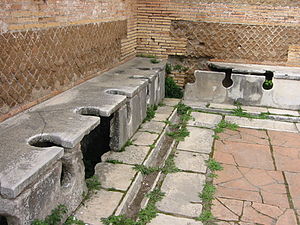- Image via Wikipedia
It’s estimated that around 2.6 billion people around the world make do without any sanitation, including more than 10 million in the slums of Kenya.
Still more have to use thinly disguised holes in the ground. A group of MIT students have joined forces to try and create a sustainable toilet solution for those in need. They’ve developed a low cost, modular sanitation solution which would be operated and maintained by locals and the waste transported to nearby processing plants. Biogas produced from the waste will be used to create electricity and what’s left of the human waste turned into fertilizer.
As you complain about the state of the toilets at the latest rock festival, spare a thought for those who have it much worse. A huge chunk of the world’s population is either denied any sanitation at all or make use of so-called pit latrines – where holes in the ground are surrounded by ramshackle sheds generally erected using foreign aid funding. Such funding doesn’t pay for their upkeep though and they soon fall into disrepair.
The long term aim of the Sanergy project is to create a sustainable sanitation cycle in high density informal settlements where the availability of such services are low. Sanergy is made up of MIT students who have developed a model which will see sanitation centers paying for their own upkeep and also generating income and power for local people.
The project proposes a network of franchised, low cost sanitation centers being constructed in slum areas, like those of Kisumu (one of the largest slums in the world). Each center would measure 10 x 6 feet and provide clean, hygienic shower and toilet facilities to meet the needs of around 200 people. The day-to-day operation of the centers will be franchised to local people who will generate wages and maintenance funds by charging users a small per use or subscription amount of, say, about a dollar a month. Further income could be generated by the sale of basic toiletries.









